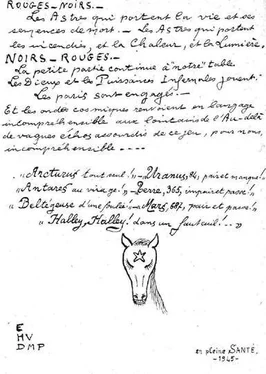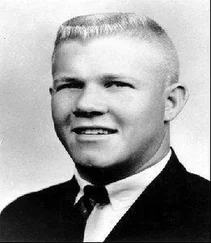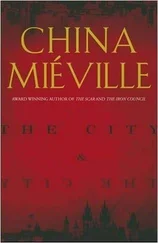Other neighbors had witnessed the same event. Andrée Marçais, the thirty-four-year-old woman in No. 22 whose husband had made the first call to the police about the smoke, remembered that the vehicle was gray, and there were two or three men piling luggage into the truck. Yvonne Staeffen on the fifth floor believed that one of the men was the stranger who came regularly on the bicycle. “With my daughter,” Staeffen said, “we have amused ourselves by counting the suitcases.” They reached forty-seven, but they had not started from the beginning.
It was the eyewitness account of Angèle Lalanne of 26 rue Le Sueur that brought the police one crucial step closer to finding the truck. She reported seeing a sign on the old vehicle: TRANSPORTS AVENUE DAUMESNIL. Massu now had something tangible to pursue.
An investigation into the transport companies and garages on the two-mile-long avenue, however, did not immediately turn up any valuable information. At one point, the detectives stopped by the Hôtel Alicot and struck up a conversation with a group of truckers. One of them, Emile Henri Pintrand, remembered that the man in the police photograph, Maurice Petiot, had approached him the previous summer about a delivery. Pintrand had declined because he was already busy that day. His friend, Leopold Sturlèse, had accepted.
But when Sturlèse arrived at the rendezvous at the Hôtel Alicot as planned, he learned that Maurice had hired someone else and the delivery had already been made. After a wild-goose chase to find this person, the inspectors discovered that the driver of the truck had been Maurice Lion of the Manjeard Company.
Lion verified that he and Maurice had loaded a number of suitcases onto his gray Renault truck and driven them to Gare de Lyon. A quick visit to the baggage office at that station revealed that, on May 26, 1943, train number 2001 had carried three separate shipments of a total of forty-five suitcases, weighing 683 kilograms, to the nearby town of Courson-les-Carrières:
Group No. 18
11 suitcases
160 kilograms
Group No. 235
18 suitcases
280 kilograms
Group No. 436
16 suitcases
243 kilograms
All of these suitcases were signed for by Albert Neuhausen, the man both Monique and Maurice Petiot had claimed slept in their property in Auxerre. Neuhausen immediately became a key figure in the ongoing investigation.
On March 30, 1944, when the police came to search his electronics shop in Courson-les-Carrières, he was not there. His wife, Simone-Andrée, however, admitted knowing about the suitcases. Maurice had brought them to the house the previous summer, claiming that they belonged to his brother, who had been arrested by the Germans. The arrest had happened just five days before. Had Maurice moved the suitcases to avoid seizure by the Gestapo?
Madame Neuhausen promptly escorted Massu, Inspector Battut, and a couple other detectives up to the attic, which was filled with suitcases stacked neatly in rows. Some were made of leather, a few still in dustcovers or carrying labels such as grand hotel amsterdam; others were plain, even plywood, like many made during the Occupation. Several of the suitcases still carried baggage tickets from Gare de Lyon.
There were, in fact, forty-nine pieces of luggage in Neuhausen’s attic. Thirty-seven of these were from the shipment from Gare de Lyon; the other twelve were not previously known. There were a few trunks, which were so heavy that they could not be carried down the steps and had to be lowered by rope through the dormer window. The suitcases were placed on the police truck for delivery to the station. Half of the village, Massu said, seemed to be standing outside watching.
As rain poured down, police cars brought what Massu called “the most tragic cargo” to the headquarters at 36 quai des Orfèvres.
Reporters, sensing a scoop, descended on the building. As cameras popped, Massu, umbrella in hand, helped unload the suitcases. Rain splashed on the evidence, threatening to rub off the ink of the luggage tags. Five inspectors carried the trunks up to the third floor, which, as Massu put it, soon looked like a hotel lobby, while his office resembled a luggage room in a train station.
The contents of the suitcases would prove remarkable. Inside, in no apparent order, were a total of 79 dresses, 26 skirts, 42 blouses, 48 scarves, 52 nightgowns, 46 pairs of panties, 14 dressing gowns, 13 negligées, 77 pairs of gloves, 35 belts, 25 handbags, 26 hats (women’s), 10 pairs of boots, 6 jackets, 5 fur coats, 3 mink stoles, and 311 handkerchiefs. There were also 115 men’s shirts, 104 cuffs, 82 pairs of socks, 66 pairs of shoes, 29 men’s suits, 14 overcoats, 4 pairs of slippers, and 3 pairs of swimming trunks, in addition to an assortment of towels, tablecloths, sheets, pillowcases, pajamas, nightshirts, raincoats, eyeglasses, handbags, hairnets, hatpins, nail files, cigarette cases, and bus tickets. In short, there were 1,760 items in the inventory.
Analysis of the contents of these suitcases, Massu hoped, would provide clues to catch the killer and evidence to prosecute him afterward. It might also, with a great deal of time and perseverance, help identify the many victims and perhaps even answer the most difficult question of all: namely, the motives for the grisly murders.
17.
FRUSTRATION
IF SHE HAD COMMITTED SUICIDE, IT IS VERY LIKELY THAT [HER] BODY WOULD HAVE BEEN FOUND.
—Commissaire Massu
ALBERT Neuhausen was found on March 31, 1944, at the Hôtel Alicot. When detectives questioned him, Neuhausen reaffirmed that he was only holding the suitcases for his friend Maurice Petiot, who had done many favors for his family, including giving them a loan to buy their house. Neuhausen said that he had never looked through the suitcases, claiming no curiosity whatsoever about their origins or contents. A detective asked if this had changed after he read the newspaper accounts of the events at rue Le Sueur.
“I do not read the newspapers,” Neuhausen said. “I have never heard anyone speaking about it.” He claimed only to have learned of the discovery of the crime while staying at the Hôtel Alicot on a business trip.
The search of Neuhausen’s property had, however, uncovered a number of items that had clearly been removed from the suitcases. In the bedroom of their sixteen-year-old son, Christian, was a man’s wardrobe, including a suit and an overcoat. In Albert and Simone’s bedroom were a number of other personal items that police believed had been unpacked from the suitcases.
Confronted with the evidence, Neuhausen no longer denied opening and taking a few things from the trunks. Around March 27, he said, he and his wife had gone to the attic and looked through “three or four” suitcases that were not locked. He had also used one of the suitcases for a trip to Paris, reasoning, “Now that Dr. Petiot is in flight, I can just as well take something. He will never come to reclaim it.”
Neuhausen had other information for the police. About two or three months after the arrival of the suitcases, Maurice Petiot had come to the house. Neuhausen escorted him to the attic and returned to work. He did not know if Maurice had opened or rummaged through the suitcases, or if he carried anything away. Another time, Maurice had brought Georgette Petiot to his attic. Again, he claimed that he did not know if they opened or removed anything, as he had left them alone and he had not seen them leave. His wife, Simone, on the other hand, did. She told the police that they had taken two suitcases.
In light of the discovered luggage in Neuhausen’s attic, the Brigade Criminelle made another search at 21 rue Le Sueur. The haul, this time, was smaller: a white shell necklace, a pearl necklace in earthenware, a toothbrush in a white-and-red case with the words extra hard on it, and a framed portrait of socialist leader and former prime minister Léon Blum. Among other things, there were also a thermos, a pipe, a tube of Vaseline, a Gillette razor, soap from Marseille, a Vienna newspaper dated October 26, 1942, and a shoehorn inscribed with the name hôtel europa, dresden.
Читать дальше












